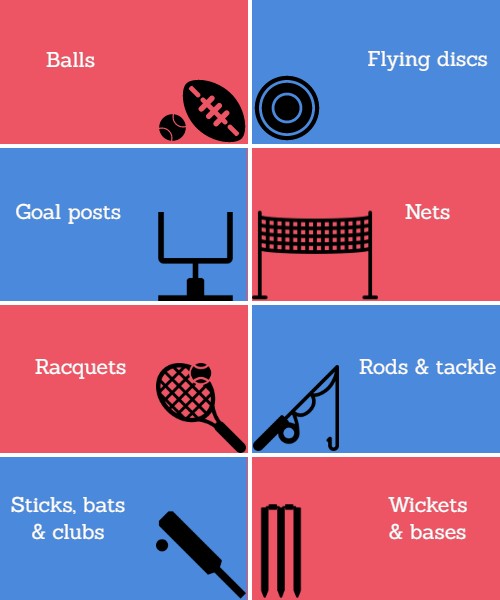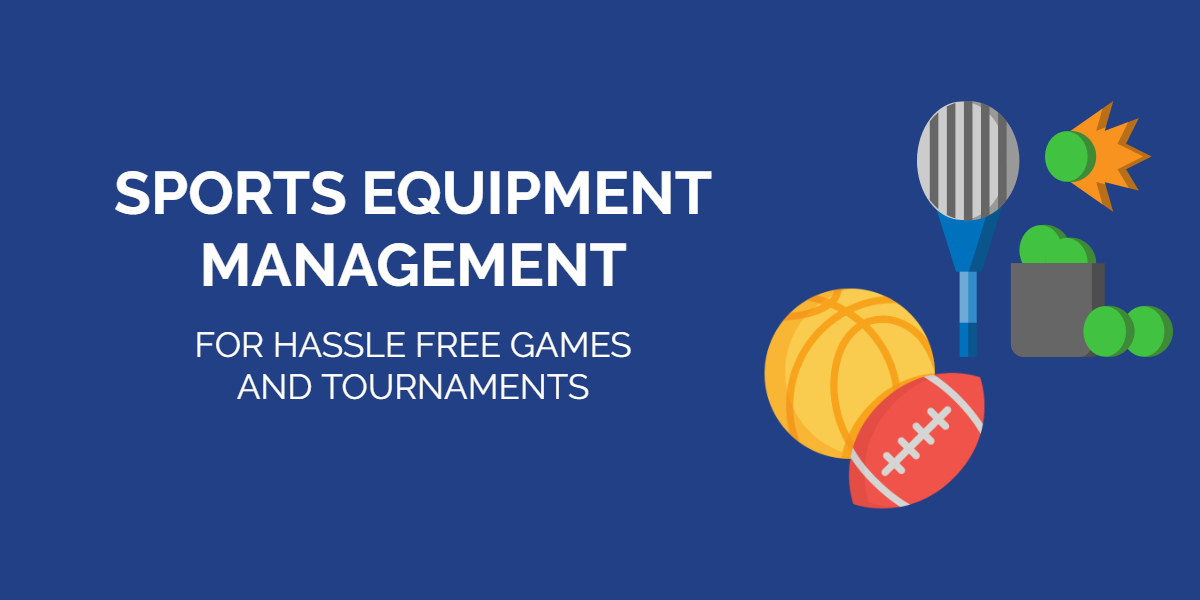What is sports equipment management?
Sports equipment management relates to organizing, monitoring and reporting on any equipment used by sports facilities. Sports facilities can include training centers, gymnasiums, stadiums, sports federations, and even universities. They can host several activities, tournaments, and training sessions.
All of these events use a wide range of gear, which greatly complicates the process of monitoring and servicing. This, coupled with the rise of injuries in sporting events, calls for better sports equipment management practices.
A sports equipment manager takes care of procurement, maintenance, and the disposal of sports gear for their company. They also ensure that all equipment meets functional and safety requirements before being utilized by players. Meeting these regulations is critical if you wish to avoid athlete accidents stemming from poor maintenance of equipment.
Sports equipment is divided into the following categories:
1. Games equipment
This includes sports equipment like balls, rackets, and goal posts that enable you to play a sport. Here’s a complete overview of what sort of items this category includes:
- Balls, which are a requirement for almost every sport.
- Flying discs, which are used for sports such as freestyle frisbee and disc golf.
- Goal posts, that are a necessary part of sports such as football and rugby, though both require different types of posts.
- Nets, which you can find in sports such as badminton, tennis, table tennis and basketball.
- Racquets, which are essential for the sports category called ‘racquet sports’.
- Rods and tackles, which include fishing rods and fishing tackle.
- Sticks, bats, and clubs, that are used in sports such as hockey, cricket, baseball, and golf.
- Wickets, which are a part of cricket, and bases that are used in baseball.

2. Player equipment
This is gear worn for player safety like footwear, training essentials and helmets. It further includes 3 different categories, which we discuss below:
- Footwear: Different sports have different types of footwear. For example, boards are footwear for surfing, skateboarding, etc. Other common types of footwear include roller skates, skis, football boots, cricket spikes, and running shoes.
- Protective equipment: Players generally wear these items in contact sports and motor sports where there is a risk of injury either through collision with other players or with other objects. Examples of protective equipment include football helmet, mouthguards, sports gloves, shoulder pads, and shin pads.
3. Vehicles
These are used for specialized sports activities such as engine sports. These are also used for transportation during sporting events, such as items like golf carts.
Benefits of automating equipment management
The use of technology in the sports field is growing rapidly. In addition to helping players and referees run seamless events, software programs enable sports managers to keep everything organized. By having quick access to data on the cloud, you can optimize daily sports activities for improved performance.
An automated system can do wonders for your sports equipment management. Here are a few benefits:
1. Eliminate manual work errors
Manual record-keeping is bound to result in errors if you’re housing several different types of sports equipment. Even the smallest of errors can lead to major setbacks. Moreover, manual record-keeping is a time-consuming process. And correcting any errors only ends up costing you more time.
In addition to all of this, let’s not forget that sorting through piles of spreadsheets or deciphering written information only leads to equipment getting lost or misplaced. If you opt for a cloud based system, you can maintain reliable inventory lists at all times.
2. Benefit from real-time feedback
When you have access to instantly updated stock information, you can optimize your management practices according to data insights. You can analyze changes in inventory to gauge consumer preferences as they shift in response to seasonal changes. Keeping up with the latest trends helps companies drive up sales and profits.
Moreover, having access to real-time data increases transparency. You’ll always know where an item is, therefore minimizing chances of theft or loss.
3. Enforce tighter security
Sports organizations maintain a collection of sensitive information regarding vendor and equipment details. This cannot be lost at any cost. In order to keep all your data safe, choose a cloud-based program that automatically backs up your data and provides strict user surveillance and access control. Use this to lower the risks of breaches and fraudulent activities.
Key features of sports equipment management software
Running a sports facility requires dedicated management so your team can smoothly sail through all events. For this reason, institutions often lay down basic guidelines that dictate the optimal utilization of all resources. By following this set structure, you can upgrade performance and minimize the risks involved. A robust management plan allows you to carry out the following practices:
1. Generate customized barcodes
Sports equipment can comprise of several small items like tennis balls and racquets. If not properly tracked, you run the risk of losing them due to employee carelessness or theft. This is why knowing what is moving in and out of your inventory is critical.
Efficient tracking starts with comprehensive labels. Equipment tags have come a long way from simple barcodes to RFID tags. Every kind of label offers specialized functionality but to this day, barcodes remain a popular choice.

Once you choose the right label for your needs, list down the information that you’d like to feature on your labels. This data can include anything that will facilitate your equipment management, from manufacturer details to handling instructions. Attach the tags to your entire inventory and you’re good to go!
Labeling equipment is very important in ensuring that everything is accounted for. Intuitive labels will allow you to streamline check-ins and checkouts, trace equipment custody, and easily identify cases of equipment misplacement or theft.
Read more: Asset Tags , Recommendations and Best Practices
2. Run streamlined procurement
Most companies with sizable inventories struggle with equipment restocking. This is because they lack the means to monitor equipment usage and history. In the absence of efficient record-keeping, you’ll have a hard time deciding what and when to stock.
Moreover, there isn’t any way you can know you’re running low on equipment and need to procure more. This ends up causing a shortage of equipment that negatively impacts your business or facility.
Tracking usage history enables companies to procure equipment in a timely manner to avoid shortages. With a way to discern that most of your footballs wear out at the end of a month, you will always be able to restock them before you run out.
Furthermore, you can also set up alerts when your inventory hits a low stock level. By setting low stock level thresholds, you can notify vendors in a timely manner for procurement requests. So you’ll always have enough equipment!
3. Reserve equipment in advance
Most sports facilities organize tournaments that feature consecutive events spanning over a number of days. The most common challenge in handling these events is to get all required equipment in order and at the venue.
An efficient way to adhere to deadlines is to book all your equipment in advance. This helps ensure that there are no conflicts at the time of the event. An availability calendar allows you to see which goods are taken out for maintenance or are temporarily unavailable during a certain time period. While making reservations, you can also see alternate options so you never have to cancel an event due to the lack of gear.

Let’s look at an example where you’re managing a school’s sports activities. You need to ensure that the swimming pool and corresponding safety gear, such as kickboards and fins, are always available for the weekly swimming session. Luckily, this is easily achievable with an availability calendar.
Read more: How Reservations in Asset Tracking Software Enhance Workplace Efficiency
4. Schedule timely maintenance
To keep all sports equipment functional, it is critical to run routine maintenance sessions. Unexpected breakdowns can be dangerous and inflict serious injuries. We recommend scheduling repair and service events for each active item so your equipment is always safe to use.
You can easily automate the whole ordeal by using a software that lets you check-in items for maintenance as soon as you procure them. Automated maintenance also helps take care of recurring services so you never miss out on a session.
With a streamlined maintenance schedule, you can send out email alerts to your entire staff so they know that a brand of snowshoes has been checked in for maintenance. This way, they can schedule activities and make alternate arrangements well before time.
In a well put-together sports equipment management structure, a common maintenance event for sports facilities includes:
- A thorough inspection to identify any damage.
- Identification of items that require extensive service.
- Recommendations for decreasing equipment downtime.
- Issuance of a health and safety certification for cleared equipment post completion.
5. Create activity bundles

Sports companies create product bundles to group together goods that usually go out together. This helps save time during checkouts and enables easy retrieval after use so you can schedule all of your sports events seamlessly. Many centers create bundles according to the sports that they feature, like a badminton bundle that includes rackets and shuttles or a cricket bundle with bats, balls, and stumps.
Instead of hunting for individual items, simply check out a bundle at the time of the activity. Your equipment management setup can also offer add-ons so any additional equipment that might be useful is also easy to checkout.
Use sports equipment management for seamless events
Carrying out sports events is a lot of responsibility as the health of the players falls on the management’s shoulders. Several sports accidents occur stemming from their negligence and the consequences can be catastrophic for an individual’s life.
To ensure the safety of players, it is strictly recommended to carry out health and quality compliance audits. An organization should opt for both internal and external audits to check if any serious changes need to be made in the operations. Moreover, such practices also help maintain credibility as they let you verify ownership of assets.
A successful sports facility puts its athletes first. Ensure that you are too, by regular inspection at various points in the equipment’s life cycle and meeting sports and recreation compliance standards.
About EZOfficeInventory
EZOfficeInventory is sports equipment inventory software that helps facilities track their sports equipment, schedule maintenance, and organize smooth sports events. Sign up for our free 15-day trial and use our asset tracking software to arrange seamless tournaments!







